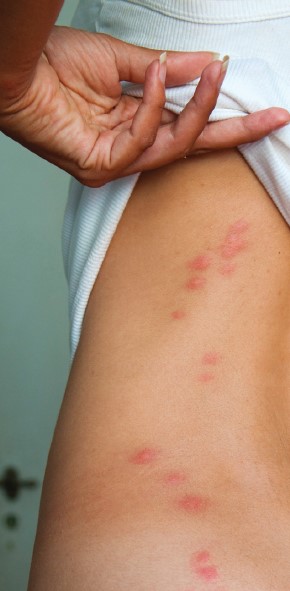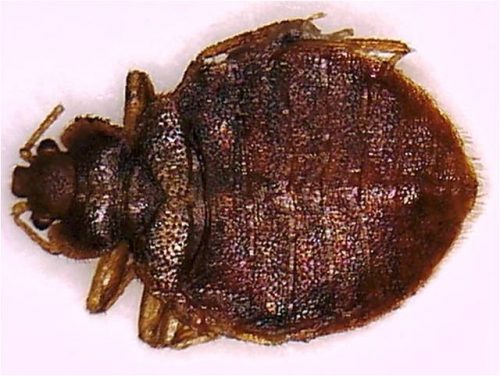
Early identification of bed bugs is essential to managing this resurging insect.
Bed bugs reside in crevices of floors and walls, bedding, and upholstered furniture. They are wingless and cannot fly but can travel up to 20 feet in search of a human host. After feeding for 10 to 20 minutes the bed bug will return to its place of hiding. Bed bugs usually feed every few days and can survive for 14 months without feeding. Places with high turnover of residents are often associated with bed bugs.
Currently there is no evidence that bed bugs transmit blood-borne infectious diseases such as Hepatitis B, Hepatitis C or HIV. It has been determined that these viruses do not replicate inside the insect’s body, and animal model studies have never been able to demonstrate insect-to-animal transmission.
Infestations, however, can cause secondary infections and allergic reactions and can contribute to poor self-esteem, difficulty sleeping, anxiety, depression, and financial hardship.
You should suspect bed bugs in any patient with nocturnally acquired bites or rashes. Bite reactions occur on exposed body sites such as face, neck and extremities – most often the arms and shoulders. The rash may or may not be pruritic.
Patients may report seeing small flat bugs, typically at night. They may also report signs of an infestation – small reddish brown stains or black spots on sheets or mattresses and/or cast skins of bed bugs.
Bite reactions occur on exposed body sites such as face, neck and extremities – most often the arms and shoulders.
Other clues to bed bugs as the cause may be staying in a place of high resident turnover (hotel, hostel, shelter, rooming house, etc.) or use of second-hand furniture/mattresses. You should determine if the patient has certain fears about other diseases or beliefs about cleanliness around bedbugs as well as any impact this may be having on their emotional and social well being.

Bites are typically erythematous or urticarial papules although other rarer reactions (bullae and vesicles) are possible. Purpuric macules may be the only manifestation in a nonsensitized patient. Note the location of the bites and determine if they correlate with exposed areas of skin (not clothed during sleep).
The bites may be in a linear or clustered pattern. The classical distribution of the rash in linear groups of three is known as the “breakfast, lunch, and dinner sign.” Changes secondary to scratching include excoriations, eczematous dermatitis, and secondary infections.
Systemic reactions have been described, including asthma, generalized urticaria, angioedema, iron deficiency anemia, and, very rarely, anaphylaxis.
Bed bugs are oval, reddish-brown, flat and wingless. Adults are typically 4 to 7 mm in length. Nymphs can be as small as 1 mm, and may be lighter in colour or translucent.

Definitive diagnosis depends on identification of the bed bug. This can be done through a pest control company. However, the patient’s history and physical examination would usually be sufficient to support a clinical diagnosis.
The differential diagnosis of bed bug bites includes dermatitis herpetiformis, drug eruptions, ecthyma, other insect bites, pemphigus herpetiformis or scabies. Scabies tends to affect covered skin such as the axillae and periumbilical area. Fleas are only on the extremities, usually of pet owners. Both flea bites and scabies rarely affect the face.
Bed bug bites do not usually require any medical treatment. Creams with corticosteroids and oral antihistamines may be advised in more severe cases.Topical therapy with mupirocin 2% cream or fusidic acid 2% cream can be used for uncomplicated secondary infections.
The affected person should resist the urge to scratch the bites, as this may intensify the irritation and itching and may lead to secondary infection.
The best solution is to get rid of the bed bugs. Elimination of bed bugs requires the removal of clutter and meticulous cleaning, including vacuuming and laundering of clothing and bedding (washing and drying using highest heat settings).
Infestations may require the use of a licensed pest control company to provide a number of pesticide treatments over several weeks. Toronto Public Health defines an infestation as a breeding population of bed bugs within a residential unit evidenced by 2 or more stages of the bed bug life cycle (eggs, live nymphs, live adults) AND cast skins and fecal spotting. Patients who are tenants need to refer this matter to their landlord.
Toronto Public Health maintains a public website with comprehensive information on bed bugs and also offers assistance over the phone.
Be sure to remind your patient that even the cleanest people can get bed bugs whether at home or a five-star hotel.